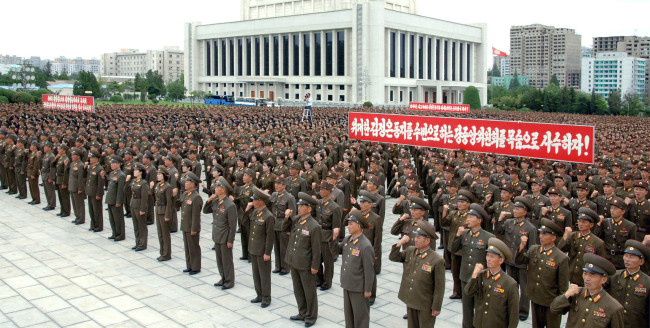The new wartime contingency plan of South Korea and the U.S. is presumed to address the growing concerns over North Korea’s evolving weapons of mass destruction and likely to reflect changes in the U.S. force structure and strategy, analysts said Thursday.
 |
North Korea soldiers pledge allegiance in front of the statues of North Korea’s national founder Kim Il-sung and former leader Kim Jong-il on Tuesday. (Yonhap) |
Seoul and Washington reportedly signed the so-called Operations Plan 5015 in June to replace OPLAN 5027, the core wartime plan that laid out detailed procedures for the allied militaries to handle a full-blown war initiated by North Korea’s aggression.
Observers assumed that the new plan might entail a series of new procedures to more aggressively eliminate Pyongyang’s nuclear arsenal and other weapons of mass destruction, and respond to cyberattacks and other wartime scenarios.
The U.S. Pacific Command in charge of security on the Korean Peninsula told The Korea Herald that the South Korea-U.S. operations plan “has and will continue to evolve” to better handle regional security challenges.
“The U.S. Pacific Command regularly reviews and updates operations plans to ensure our joint forces are ready to respond to regional threats and crises,” PACOM said via email.
“The joint ROK (Republic of Korea)-U.S. operations plan has and will continue to evolve to enhance readiness and strengthen the ROK-U.S. Alliance’s ability to defend the Republic of Korea and maintain stability on the Korean Peninsula.”
Apart from the new plan’s likely emphasis on removing the North’s nuclear arms and other WMDs, it is thought to reflect ongoing changes in the U.S. military structure, troop capacity and strategy.
One of the key points, which military experts here pay attention to, is whether the new plan sets the level of U.S. troops to be augmented for a peninsular contingency at the same level under OPLAN 5027.
OPLAN 5027 is known to stipulate that the U.S. is to deploy 690,000 troops, and mobilize 160 military vessels and 2,500 aircraft within 90 days of the outbreak of war on the peninsula. Most of the troops are to come from Okinawa, Guam and the U.S. Pacific Command headquartered in Hawaii.
Some observers have argued that the massive U.S. troop mobilization under OPLAN 5027 may be unrealistic given that Washington, struggling with budget constraints, has been reducing its ground forces.
But Park Won-gon, security expert at Handong Global University, raised the possibility that the allies might have kept the U.S. troop deployment level at the same level as OPLAN 5027 in a “symbolic” move to deter North Korea’s aggression.
“Above all, what matters is the psychological warfare against North Korea. Leaving the large figure in the new war plan might have the effect of deterring North Korea’s aggression,” he said.
After focusing mostly on counterinsurgency and counterterrorism operations for more than a decade, the U.S. military has been seen shifting its focus to aerial and naval operations in an apparent move to counter growing China threats.
With the force realignment and a shift in military doctrines, the U.S. has sought to reduce its ground forces and employ high-tech operational tools such as long-range precision-strike systems and drones. This might have influenced the formulation of OPLAN 5015, experts said.
Touching on the cuts in U.S. troops, Bruce Bennett, senior defense analyst at RAND Corp., noted the need for South Korea to step up efforts to maintain its troop level that could decrease due to ongoing demographic changes.
“All U.S. military forces have been reducing in size. The smaller U.S. Army and Air Force, in particular, have fewer personnel to send to any contingency,” he said. “But in fairness, the ROK Army has been reducing about as rapidly as the U.S. Army, and will accelerate its reduction in personnel over the next 10 years.”
Seoul and Washington were working to formulate OPLAN 5015 in line with their preparations for the transfer of wartime operational control, which was slated for December 2015.
Due to North Korea’s evolving nuclear threats, the transfer has been delayed and is expected to take place in the 2020s. But the work to craft the new operational plan reportedly proceeded as planned.
Operational plans involving U.S. forces are named based on the codename of each U.S. overarching military command that executes those plans. OPLANs involving the U.S. Pacific Command begin with No. 5. As the U.S. Forces Korea is under PACOM, operations plans involving the USFK thereby begin with No. 5.
By Song Sang-ho (
sshluck@heraldcorp.com)








